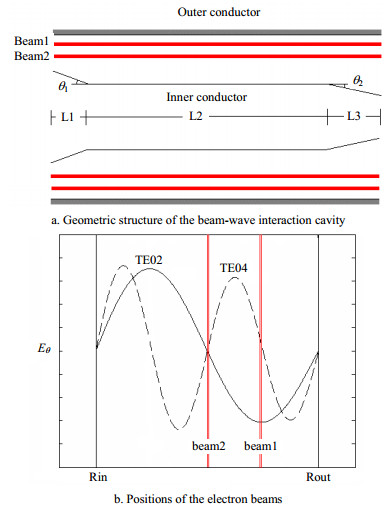-
Two of the main goals for the development of microwave sources in practical applications are to increase the radiated power and to shorten the wavelength. Unlikely so-called “slow-wave” microwave devices, “fast-wave” devices such as gyrotron oscillators rely on a resonance between the modes of an open resonant cavity and the electron beam in a magnetic field. The resonant cavity is usually overmoded, so its physical dimension can be much larger than the operating wavelength. This permits high peak and average power operation even at millimeter and THz region without risking the damage to the interaction cavity[1-4]. Gyrotrons are the most powerful sources of millimeter, sub-millimeter and terahertz wave radiation capable of continuous-wave operation[5-7]. They are important for numerous applications, which include plasma diagnostics[8], electron-spin resonance spectroscopy[9], enhancement of NMR sensitivity using dynamic nuclear polarization[10-13], standoff detection and imaging of explosives and weapons[14], new medical technology[15], atmospheric monitoring chemical technologies, and production of high-purity materials.
The coaxial cavity gyrotron with two electron beams (CGTB) was proposed in references[1-2]. CGTB has some distinct advantages: the space charge effects are decreased; the mode competition is improved; the loading of the cathode is released. It is of significance for the fusion research, the radar system, and other applications as well. Meanwhile, when one electron beam operates at fundamental cyclotron harmonic, the other beam operates at higher cyclotron harmonic; CGTB can operate at two modes with different operating frequencies simultaneously[16].
-
Dual-frequency operation CGTB is a special operation of CGTB: one beam works at the first cyclotron harmonic while the other at the higher cyclotron harmonic. It means that the dual-frequency operation CGTB can provide high power with two different frequencies. It is significant for the fusion research, the radar system, and other applications as well. The geometric structure of the beam-wave interaction cavity and the positions of two electron beams are shown in Fig. 1. The outer and inner radii are 3.5 mm and 6.23 mm, respectively. The operation modes are TE02 and TE04 modes, and the corresponding operation frequencies are 0.11 THz and 0.22 THz.

Figure 1. Geometric structure and the position of electron beams of the dual-frequency operation CGTB
The field distribution of Eθ and the spectrum of the dual-frequency operation CGTB are presented in Fig. 2 with PIC simulation. It is found that the two operation modes can work simultaneously.
-
The prototype of CGTB is shown in Fig. 3. The measurement devices consist of a calorimeter which is used to measure the pulsed output power and convert a pulsed power signal into a pulsed voltage signal, a detector which is used to detect the signal operating at the fundamental cyclotron harmonic, and a frequency mixer which is used to measure the frequency at the second cyclotron harmonic. The measurement result of the output power with a calorimeter is shown in Fig. 4, and the output power is about 20 kW.
The experimental setup to measure the frequencies is shown in Fig. 5a. Fig. 5b shows the results of the frequency measurement of the dual-frequency operation CGTB. The red line is the signal detected by the detector which is used to detect the fundamental cyclotron harmonic signal; the blue line is the IF signal from the frequency mixer which is utilized to measure the second cyclotron harmonic signal; the yellow line is the pulsed high voltage of the dual-frequency operation CGTB.
-
A method was proposed to separate radiations from a dual-frequency operation pulsed gyrotron efficiently. Figure 6 depicts the device which separates radiations from a dual-frequency operation pulsed gyrotron with two electron beams. It mainly consists of a launcher as an antenna, a quasi-elliptical mirror which focuses the beam transversely, a quasi-parabolic mirror which focuses the beam longitudinally and a spatial filter based on frequency selective surface which separates the two different-frequency linearly polarized beams efficiently.

Figure 6. Sketch of the device to separate radiations from a dual-frequency operation pulsed gyrotron
For these operation modes TE02 and TE04 in the dual-frequency operation coaxial gyrotron with two electron beams, they have the similar Brillouin angle θB, the same caustic radius Rc, and the similar launcher cut length Lc, so the QO mode converter can efficiently convert these two modes into linearly polarized Gaussian beams simultaneously, and these two different-frequency linearly polarized Gaussian beams are superposed at the output window of the QO mode converter, as shown in Fig. 7.
For the practical applications, a spatial filter based on FSS is utilized to separate the output power with two different frequencies efficiently. The Jerusalem cross is utilized as the resonant cell of the filter. The substrate of the filter is the sapphire whose refractive index is 3.1 in this frequency range, and the depth of the substrate is 430 μm, The Jerusalem crosses (yellow part as shown in Fig. 8) are made of aluminum. The detailed structure parameters of the resonant cell are depicted in Fig. 8. When the linearly polarized Gaussian beams with two different frequencies are oblique incident toward the spatial filter, as shown in Fig. 8, the 0.11 THz linearly polarized Gaussian beam is reflected, and the 0.22 THz linearly polarized Gaussian beam is transmitted.
The transmission characteristics of the spatial filter based on FSS are simulated with the commercial software HFSS and presented in Fig. 9. The linearly polarized beam at 0.11 THz is totally reflected, and the linear polarized beam at 0.22 THz is transmitted and the transmittance is about 95%. The transmission characteristics of the spatial filter change little when the incident angle ranges from 0 to 30 degree.
-
The coaxial gyrotron with two electron beams has some distinct advantages: the space charge effects are decreased; the mode competition is improved; the loading of the cathode is released. It is of significance for the fusion research, the radar system and other applications as well. When one electron beam operates at fundamental cyclotron harmonic, the other beam operates at higher cyclotron harmonic, the coaxial gyrotron with two electron beams can operate at two modes with different operating frequencies simultaneously. In this paper, the theoretical investigation on dual-frequency operation CGTB including the numerical calculation and PIC simulation was conducted and the results show the power of the high harmonic can be enhanced due to the nonlinear coupling between two electron beams. The prototype of dual-frequency operation CGTB is fabricated and the verification experiment is conducted, the operation frequencies are at 0.11 THz and 0.22 THz, and the output power is about 20 kW. A method to separate the radiations from the dual-frequency operation CGTB efficiently is proposed. With the quasi-optical mode converter, the operation modes in the dual-frequency operation CGTB is converted into linearly polarized Gaussian beams simultaneously, and these two different-frequency linearly polarized Gaussian beams are superposed at the output window of the QO mode converter, a spatial filter based on FSS is utilized to separate the output power with two different frequencies efficiently. When the linearly polarized Gaussian beams with two different frequencies is oblique incident toward the spatial filter, The 0.11 THz linearly polarized Gaussian beam is reflected, and the 0.22 THz linearly polarized Gaussian beam is transmitted.
Theoretical and Experimental Investigations on a Dual-Frequency Operation Coaxial Gyrotron with Two Electron Beams
-
摘要: 该文章研究双频工作同轴双电子注回旋管。数值计算和粒子模拟结果表明同轴双电子注回旋管可以同时工作在两个不同的频率,且由于两个电子注间的非线性耦合,高次回旋谐波所对应模式的功率显著增强。完成了双频工作的同轴双电子注回旋管的原理样管加工并进行了验证性实验,实验测得两个工作频率分别为0.11 THz和0.22 THz,输出功率20 kW,并提出了一种分离双频工作同轴双电子注回旋管中两个不同频率电磁波功率的方法。Abstract: The dual-frequency operation coaxial gyrotron with two electron beams is investigated in this paper. The results of the numerical calculation and particle in cell (PIC) simulation show that the coaxial gyrotron with two electron beams (CGTB) can operate at two different frequencies simultaneously. In addition, the power of the high harmonic can be enhanced due to the nonlinear coupling between two electron beams. The prototype of CGTB was fabricated and the verification experiment was conducted. The operation frequencies are at 0.11 THz and 0.22 THz, and the output power is about 20 kW. A method to separate the radiations from a dual-frequency operation gyrotron is also proposed.
-
-
[1] LIU S G, YUAN X S, FU W J, et al. The coaxial gyrotron with two electron beams. I. Linear theory and nonlinear theory[J]. Phys Plasmas, 2007, 14:103113. doi: 10.1063/1.2784766 [2] LIU S G, YUAN X S, LIU D W, et al. The coaxial gyrotron with two electron beams. Ⅱ. dual frequency operation[J]. Phys Plasmas, 2007, 14:103114. doi: 10.1063/1.2784767 [3] LIU D W, Y YAN, LIU S G. Characteristics analysis of a coaxial cavity with a misaligned inner rod[J]. IEEE Trans Electron Dev, 2012, 59:230-233. doi: 10.1109/TED.2011.2171348 [4] BYKOV Y V, GINZBURG N S, GLYAVIN M Y, et al. The development of gyrotrons and their applications for plasma science and material processing[J]. Terahertz Science and Technology, 2014, 7:70. http://cn.bing.com/academic/profile?id=2186851751&encoded=0&v=paper_preview&mkt=zh-cn [5] RZESNICKI T, PIOSCZYK B, KERN S, et al. 2.2-MW record power of the 170-GHz European preprototype coaxial-cavity gyrotron for ITER[J]. IEEE Trans Plasma Sci, 2010, 38:1141-1149. doi: 10.1109/TPS.2010.2040842 [6] BRATMAN V L, BOGDASHOV A A, DENISOV G G, et al. Gyrotron development for high power THz technologies at IAP RAS[J]. J Infrared Milli Terahz Waves, 2012, 33:715-723. doi: 10.1007/s10762-012-9898-6 [7] BARNES A B, NANNI E A, HERZFELD J, et al. A 250 GHz gyrotron with a 3 GHz tuning bandwidth for dynamic nuclear polarization[J]. J Magnetic Resonance, 2012, 221:147-153. doi: 10.1016/j.jmr.2012.03.014 [8] HIDAKA Y, CHOI E M, MASTOVSKY I, et al. Observation of large arrays of plasma filaments in air breakdown by 1.5-MW 110-GHz gyrotron pulses[J]. Physical Review Letters, 2008, 100:035003. doi: 10.1103/PhysRevLett.100.035003 [9] MITSUDO S, ARIPIN, SHIRAI T, et al. High power, frequency tunable, submillimeter wave ESR device using a gyrotron as a radiation source[J]. J Infrared Milli Terahz Waves, 2000, 21:661-676. doi: 10.1023/A:1006648223636 [10] JAWLA S, NI Q Z, BARNES A, et al. Continuously tunable 250 GHz gyrotron with a double disk window for DNP-NMRSpectroscopy[J]. J Infrared Milli Terahz Waves, 2013, 34:42-52. doi: 10.1007/s10762-012-9947-1 [11] BRATMAN V L, FEDOTOV A E, KALYNOV Y K, et al. THz gyrotron and BWO designed for operation in DNP-NMR spectrometer magnet[J]. J Infrared Milli Terahz Waves, 2013, 34:837-846. doi: 10.1007/s10762-013-0024-1 [12] MATSUKI Y, UEDA K, IDEHARA T, et al. Application of continuously frequency-tunable 0.4 THz gyrotron to dynamic nuclear polarization for 600 MHz Solid-State NMR[J]. J Infrared Milli Terahz Waves, 2012, 33:745-755. doi: 10.1007/s10762-012-9890-1 [13] BAJAJ V S, HORNSTEIN M K, KREISCHER K E, et al. 250 GHz CW gyrotron oscillator for dynamic nuclear polarization in biological solid state NMR[J]. Magnetic Resonance, 2007, 189:251-279. doi: 10.1016/j.jmr.2007.09.013 [14] KUMAR N, SINGH U, KUMAR A, et al. Design of 95 GHz, 100 kW gyrotron for active denial system application[J]. Vacuum, 2014, 99:99-106. doi: 10.1016/j.vacuum.2013.05.002 [15] LIU P K, BORIE E, KARTIKEYAN M V. Design of a 24 GHz, 25-50 kW technology gyrotron operating at the second harmonic[J]. Int J Infrared and Millimeter Waves, 2000, 21:1917-1943. doi: 10.1023/A:1006768000682 [16] LIU D W, YAN Y, LIU S G. Time-dependent multi-mode nonlinear theory of dual-frequency operation coaxial gyrotron with two electron beams[J]. Fus Eng Des, 2012, 87:1533-1535. doi: 10.1016/j.fusengdes.2012.01.017 -


 ISSN
ISSN 



 下载:
下载:









